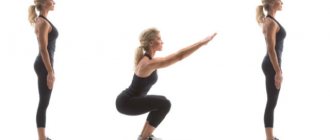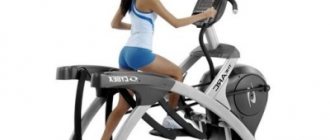Any type of physical activity uses energy. The faster and more varied a person moves, the more energy reserves he spends. How many calories are burned when walking 1 km depends on the person’s weight parameters and the pace of movement. On average it is 80 kcal. Special devices will help you determine this value more accurately: fitness bracelets, pedometers, etc.
What are the benefits of walking?
Many are accustomed to thinking that if you get cardio exercise, it must be through running, cycling or skiing. However, walking, just like the exercises listed, strengthens the cardiovascular system, being the most non-traumatic type of activity.
Here are just some of the most noticeable benefits that walking gives your body:
- helps you lose weight or maintain a healthy weight;
- long and fast walks increase endurance;
- helps prevent or manage chronic diseases;
- for people leading a sedentary lifestyle, 20 minutes of walking a day reduces the risk of premature death by 16-30% (American Journal of Clinical Nutrition study);
- for older people, an hour's walk 3 times a week reduces the risk of dementia;
- walking strengthens the heart;
- relieves stress, reduces anxiety;
- Walking as a means of cross-training allows your joints and muscles that are actively involved in running to rest;
- On a rest day from training, walking is an effective way to burn fat and increase blood flow for muscle recovery.
Ways to improve results
Physical activity does not allow you to get rid of extra pounds quickly. Even with daily intensive exercise, you can lose no more than 3 kg of excess weight in a month. The result increases many times if you simultaneously adhere to proper nutrition. It is worth noting - do not go on a starvation diet, but ensure a balanced diet.
The menu should include foods containing fats, carbohydrates, and proteins. Carbohydrates are a source of energy that is needed when playing sports. However, it should not be allowed to have more carbohydrates than the body can consume while walking. Otherwise, instead of losing weight, you will experience weight gain. Fats help carbohydrates break down, so you can’t completely give them up. It is recommended to consume nuts, dairy products, and vegetable oil. The main sources of protein are meat, eggs, and dairy products. It is imperative to follow a diet.
In addition, proper sleep and rest are very important. Weight loss occurs faster if the nervous system functions normally.
Video: Lose weight - walking is the best option for burning fat
How to walk correctly
Let's start with your cadence or stride frequency. Take short and frequent steps, as long strides can cause pain in your feet and hips. For an adult, it is optimal to take 113 steps per minute, but an accelerated pace will require about 150 steps per minute.
If you decide to replace running with walking today, for optimal results and calorie expenditure, double the walking time or spend more time. Were you going to run for 40 minutes? Then walk at a fast pace for 80 minutes.
But if you don't have enough time to walk for two hours, break up your walk. Take a walk during your lunch break and then walk home from work. This way, you will have even more free time for family and relaxation.
In general, walking, unlike running, is not incorrect from a technical point of view. Inflammation of the periosteum, stress fractures, and inflammation of the Achilles are just a small part of the injuries suffered by runners. Runners have a much higher risk of exercise-related injuries than walkers. Walkers have a 1 to 5% risk of injury, while runners have a 20 to 70% risk of injury.
marathon and half marathon training plans and start training today!
Running or walking - what to choose to burn calories
The most popular stereotype among amateurs and novice athletes is the need to run a lot, often and hard. In fact, high-intensity running training for a beginner will only cause harm to the body.
If you have never exercised, are overweight, or have had musculoskeletal injuries, then do not even try to start losing weight with running training. Your body is a collection of several systems. This includes the work of the heart and the work of the musculoskeletal system, including ligaments and joints, as well as the level of preparedness of your muscles.
Probably, if you have never run before, shortness of breath appears after a few hundred meters. Moreover, running requires more time, because after such a workout you definitely need to go to the shower, and even if not so much, you still need special clothes. It's hard to imagine running to work, especially if you have to carry a bag and backpack with you.
How many calories are burned by walking in 1 hour?
If you want to burn more calories and lose weight faster, it is, of course, better to opt for running. However, walking also provides many health benefits and helps you maintain a healthy weight.
Running will require twice as many calories as walking. However, if after running you eat a portion twice as large as usual, you should not expect weight loss.
A man weighing 72 kg will burn 300 calories in an hour of walking at a speed of 5.5 km/h. When running at a speed of 8 km/h, the same man will burn 600 calories. To achieve results in losing excess weight, we recommend combining these two types of exercise.
For example, the author of this article does not use transport if the desired destination is 3 km away or if there is a trip with transfers: you can walk to the stop from where you can leave directly. In addition, sometimes during evening traffic jams it is much faster and more pleasant to walk home or an intermediate stop than to hang on the handrail in a crowded bus.
For owners of personal vehicles, the recommendation is this: do not use your car for short distances. There are several advantages here: health benefits, no need to look for parking, saving on gasoline, reducing the load on road infrastructure. Walking is environmentally friendly!
Don't forget that it's not just your walking speed that affects the amount of energy you consume. Walking uphill will require much more calories than walking on the plain. You can find a hilly area outside or set the incline on your treadmill to 5%. Gradually increase the incline to maximum, usually 15%.
Despite all the obvious benefits of walking, you still have to watch your diet if you want to lose weight. At the National Laboratory. Lawrence Berkeley (USA) collected data from more than 15,000 walkers and 30,000 runners to determine which group lost weight more effectively.
The study found that runners were generally able to control their weight more effectively and were overall slimmer. One likely reason for this is the aftereffect of intense exercise, which increases metabolic rate and increases calorie consumption for 14 hours after activity. There is no such afterburning of calories in walking.
Another reason runners lose weight better is because of their post-workout caloric intake. In a study published in the Journal of Obesity, researchers found that walkers were more likely to overeat than runners after a 60-minute workout.
After the training, all study participants were invited to a buffet where they could choose their dishes. The walkers ate 50 more calories than they burned during exercise, while the runners ate 200 fewer calories than they burned during exercise. Runners were also found to have higher levels of peptide YY, a blood hormone that suppresses appetite. This was not observed among pedestrians.
Walking for health and weight loss
Interesting facts about walking
On average, a person conquers a distance of 1-10 kilometers every day. Strive to walk more to strengthen your cardiovascular system, improve lung function, and increase your overall endurance. Active spending time in the fresh air helps to intensively nourish every cell with oxygen and maintain a good mood. If you make an effort, you can use walking to normalize your figure by getting rid of excess fat reserves. In fact, you don’t need to make an effort or set aside special time: try replacing all possible trips by personal car or public transport by walking around the city - this simple measure will definitely be beneficial. Instead of using escalators or elevators in buildings, walk up and down on your own feet. It’s good that today there are special smart bracelets and smartphone applications that help calculate the speed and calorie expenditure when walking. We recommend taking advantage of this opportunity to accurately record your achievements and systematically increase your load.
Rules for effective walking
You need to know that walking, along with other measures for losing weight and building a beautiful body, is incompatible with an unhealthy lifestyle. That is, until you say goodbye completely and irrevocably to nicotine addiction, alcohol consumption, eating unhealthy foods, and constant stress, there can be no talk of good results from fitness classes. To quickly move towards beauty and health, you need an integrated approach. To get the maximum effect, we suggest you master Nordic walking with special poles, fat-burning walking on stairs, climbing mountains and moving quickly over rough terrain. Experts believe that you can eat before and after walking, but you need to wait 1-2 hours.
We believe that walking for less than an hour is ineffective for losing weight. When going on a fat-burning walk, know that for the first 50 minutes, calories will be consumed not from fat deposits, but from existing carbohydrate reserves. Your body will begin to break down fats the moment your glucose reserve runs out. For this reason, long walking is better for health and weight loss. Such activities speed up the metabolism, and this effect persists for some time after walking.
How fast and how long should you walk to lose weight?
Note that a leisurely walk in the park will not give you enough exercise to increase calorie burning. You need to walk quickly, although, of course, not as quickly as sports walkers rush.
Active burning of calories begins not from the fact that you make any movements, but from an increase in heart rate. For most people, brisk walking starts at 5 km/h (12 min/km). When walking 7 km/h (08:34 min/km) you will burn the same number of calories as when running at the same pace, but even a beginner can run at this pace, but not even an experienced runner can walk.
Trainers recommend varying your walking pace, just as we do during running workouts. Walk at a fast, uncomfortable pace for two minutes, then slow down to a comfortable pace. Repeat as many times as you like. In addition to actively burning calories, it will improve your aerobic fitness. Your heart rate should rise to at least 100 beats at an accelerated pace.
If you run in addition to walking, an hour of brisk walking is enough to increase your daily calorie expenditure. Thus, in Kenneth Cooper’s work “The New Aerobics: A System of Health-improving Physical Exercises for All Ages,” it is said that to achieve satisfactory fitness, you need to walk 6.5 km at an accelerated pace. In general, this is enough for an hour's walk.
So, let’s summarize the effect of walking on weight loss:
- Running burns more calories than walking, but maintaining a high intensity for a long time is more difficult.
- Due to the lower intensity of walking, a higher percentage of calories burned comes from fat burning, but there is no afterburn effect.
- Both walking and running burn enough calories to help you lose weight, but only if you make the necessary changes to your diet at the same time.
How to increase calorie expenditure while walking?
The easiest option is to walk more or faster to increase your step count. But there is another burden.
“You can hang weights on your legs or take a backpack with them,” suggests Daniil Lobakin. “Any weight gain will make exercise more difficult and create the conditions for greater caloric energy expenditure.” With weights, everything is individual. If a muscular man weighing about 90 kg is going to train, you can even choose two-kilogram weights. Girls are better off starting with 0.5 kg.
Also consider how long you will be walking with weights and where. “If you go uphill, half a kilo will be enough,” says Daniil Lobakin. - There are smaller weights - 250 g. If you walk on the plain for about half an hour, you can use kilogram ones. Everything here is very individual.” When choosing a weight, we need to take into account that we will not be walking for 2-3 minutes; according to experience, the average walking time is an hour and a half. There is no upper limit, since this is not an intense run, you can even walk all day, focusing on how you feel.
What muscles work when walking?
At a slow walking pace of less than 5 km/h, muscle activity is minimal. Power walking starts at 6 km/h. At this pace, the legs, hips, and knees are actively strengthened. The abdominal and arm muscles are used to a lesser extent; the core muscles act as a stabilizer.
When walking uphill, a good load is placed on the quadriceps, gluteus maximus and calf muscles.
Nordic walking, in addition to those already mentioned, uses the muscles of the cervical-brachial region, pectoral and scapular muscles, triceps and biceps.
Walking rules for weight loss
How many calories can you burn in an hour of walking is just one side of our question. Even such a habitual action has its own rules, features and technique. Let's name the main theses.
- Watch your posture. Correct body position is the key to effective walking. Don't slouch. Keep your head straight and look ahead. Do not lean your body forward. The neck and shoulders should be in a relaxed state.
- Move with energy. For example, swing your arms more actively. This tones the muscles of the shoulders and core, and also increases energy expenditure.
- It is recommended to keep the abdominal and buttock muscles slightly tense while walking.
- Choose comfortable shoes. Patent leather heels are not the best choice. You should also avoid shoes with thin and too soft soles (for example, moccasins). For the same reason, between sneakers and sneakers, it is better to choose the latter. A sufficiently thick, elastic and springy base will not rub the foot, will reduce the load on the joints, and will add dynamism to steps.
- The same goes for clothes. It should not restrict movement or distract your thoughts. In addition, do not forget that effective walks may be accompanied by light sweating, which indicates active energy expenditure. Make sure that in your wardrobe for this occasion there are, if not tracksuits, then at least suitable things in a casual style.
- Don't overexert yourself. Of course, after a walk there should be a certain feeling of fatigue. But severe overwork, poor health, dizziness will indicate that you have started right off the bat, and the load should be reduced by reducing the distance and time of walking.
- Choose routes that interest you and change them from time to time. Picturesque places, water embankments, areas with beautiful architecture, forested areas will be an excellent choice.
- Walking efficiency will also enhance proper breathing. You should breathe only through your nose, and the rhythm of breathing and walking should correspond to each other. When increasing the pace of movement, you must ensure that there is no shortness of breath and, if possible, do not stop breathing through your nose. When walking at a fast pace, it is permissible to breathe through both your mouth and nose at the same time, but only if the air outside is unpolluted. In frosty weather, when there is strong wind or a lot of dust in the air, it is correct to inhale through your nose and exhale through your mouth.
- If you have no health problems, then the emphasis should be on the pace of movement. And if you are going through a period of rehabilitation after an illness, then focus on distance and duration.
- In hot sunny weather, do not forget to wear a hat and take water with you.
- It’s very good if you have a fitness bracelet that allows you to control not only your movement along the distance, but also the state of your body (pressure, pulse, etc.).
- No time for walks? Walk to work (or school)! Yes, you'll have to wake up a little earlier, but believe me, it's worth it.
How long is it recommended to walk each day?
Everyone has probably heard about 10 thousand steps a day to get rid of all diseases and problems? As in the case of 2 liters of water, this is a stereotype. And it comes from Japan, where the inventor of the first electronic pedometer, Yoshiro Hatano, called it Mampo-kei. Translated into Russian, this means “10,000 steps.” One version of why Yoshiro named his invention this way is that it’s just a beautiful round number.
10,000 steps is approximately 8 km. And many, of course, are frightened by this figure. There is no need to take it literally, because there are a lot of variables: what surface a person moves on, at what speed, in what weather conditions and, finally, what kind of training a person has. Even going up from the 1st floor to the 18th-20th floor a couple of times carries a load that is much greater than idle wandering throughout the day.
A simple rule: less is better, but more is more active. Research from the Active 10 Project shows that 3 brisk, 10-minute walks a day are healthier than 10,000 slow steps. In addition, short but fast walks are better suited for the modern rhythm of life.
The recommended rate of physical activity for a person is at least 150 minutes per week. Such recommendations are given by the World Health Organization. Walking or other activity should be done at least 30 minutes a day, 5 times a week. And this is just to maintain health. Note that physical activity can be distributed throughout the day:
- 10 minutes of brisk walking three times a day;
- or 20 minutes in the morning and 10 minutes later during the day.
Doctors advise counting not the steps taken, but the total time of physical activity, but if you are still interested in the numbers of steps taken, there are now many fitness bracelets on the market with a step counting function. The same mobile applications can be installed on any smartphone.
What types of walking are there?
Globally, walking can be divided into three types:
- natural movement;
- sports and recreational walking;
- military applied movement.
This group includes the Olympic track and field discipline of race walking, in which the athlete is required to constantly keep his foot in contact with the ground.
Nowadays Nordic walking with the help of specially designed poles is experiencing an explosion in popularity. For those who want to lose weight, walking with poles is the most effective activity, since the calorie burning here is almost the same as in running. A noticeable advantage of Nordic walking is that it activates not only the leg muscles, but also the muscles of the upper body.
Read on the topic: Nordic walking: benefits, technique, beginner mistakes
Health path is a gentle form of health-improving walking. The patient usually walks under the supervision of a doctor along marked routes. One of the first health path routes in Russia was laid in 1901 in Kislovodsk. A health path involves dosed physical activity taking into account the landscape.
Healthy skiing, just like healthy running, should not cause discomfort to the practitioner. In winter, skiing becomes a good alternative to running, since such activities involve almost all muscle groups without impact on the joints. Skiing also develops your sense of balance.
Nutrition and sleep
No amount of physical exercise will allow you to lose weight if there is an excessive intake of calories into the body. You can calculate your daily calorie intake using an online calculator. Those who want to lose excess weight need to reconsider their diet and keep a strict count of the foods consumed per day. At the same time, it is forbidden to starve and overeat, since this will not only not lead to the desired result, but will also harm your health.
Walking exercises for weight loss will be effective only if they are regular and follow proper nutrition. The body must satisfy energy needs by burning fat deposits.
In the morning, it is advisable to eat 30-40 minutes before the start of training (a small meal of light food, for example, a diet shake). It is not recommended to eat food 1.5-2 hours before evening training. You can eat in 20-30 minutes. after finishing classes. At this time, the “protein-carbohydrate window” is activated, when foods are absorbed best.
| Prohibited Products | Allowed food |
| Quickly digestible carbohydrates (sweets, chocolates, bars, snacks, corn flakes) | Slowly digestible carbohydrates (buckwheat, pearl barley, oatmeal, rice, millet porridge) |
| Sweet carbonated drinks | Mineral water |
| Fatty meats | Lean meat (especially chicken) |
| Fatty fish | Low-fat fish and seafood |
| Flour | Products made from peeled flour |
| Fat cheese, sour cream and other dairy products | Low-fat cottage cheese, cheeses, milk, sour cream, etc. |
| Alcoholic drinks | Fruits and vegetables, beans |
| Caffeinated drinks | Tea without sugar |
During sleep, damaged tissues are restored, muscle fibers grow, energy reserves are replenished, digestion is enhanced, and the nervous system rests. It is recommended to sleep at least 7 hours a day, but no more than 9-10.
How far can a person walk?
For most healthy people, walking at a speed of 5 km/h is easy, and walking for 2 hours without stopping is usually not difficult. But how many kilometers can a person cover in a day?
Only a trained person can walk without stopping all day long, and for the vast majority of people, a continuous walk for 4-5 hours will be very difficult. There is already a high risk of injury if there has been no preliminary preparation with a gradual increase in volume.
In a day, with proper physical shape, you can walk 100+ km. For example, every year in Novosibirsk the Club of Tourists and Mountaineers of the SGUPS (NIIZhT) organizes the so-called “Sotka”, the participants of which complete a 100 km hike in 24 hours.
How long does it take to complete a marathon?
A standard walking speed of 5 km/h will allow you to cover the 42.2 km marathon in 8.5 hours, but such a long walk requires months of preparation, as well as good and comfortable shoes.
Professional race walkers will, of course, complete the marathon faster than most recreational runners. For example, to receive the title “candidate master of sports of Russia,” men must walk 50 km in 4:45:00 at a speed of 10.53 km/h (05:42 min/km), that is, 42.2 km at this pace. will pass in 4 hours. For masters of sports, the standard for 50 km is 4:20:00 (11.54 km/h – 05:12 min/km). Converted to a marathon distance, this equals 3 hours 40 minutes.
The world record in 50 km race walking belongs to the French athlete Yoann Dini - 3:32:33 (14.1 km/h - 4:15 min/km). He would cover 42.2 km at a walk in 2 hours 59 minutes!
Bibliography
- Bondin V.I. Kinesis-energonomic foundations for constructing physical education and health programs // Tauride Scientific Observer. – 2022. – No. 12. – Part 2. – P.28–33.
- Gortsev G. How to become slim. Secrets of losing weight. – M.: T8 RUGRAM, 2022.
- Kulakov V. N., Popov Yu. A., Tikhonov S. A., Suslov F. P. Middle and long distance running / ed. ed. V. V. Kuznetsova. – M.: Physical culture and sport, 1982. – 174 p.
- Pyastolova N. B., Gurov A. I., Taratynova O. V. Methodological foundations of independent physical exercises // Physical culture. Sport. Tourism. Motor recreation. – 2016. – T.1. - No. 3. – P.44–47.
- Tudor-Locke C., Pangrazi RP, Hatano Y., Kang M.. Revisiting “How Many Steps Are Enough?” // Medicine & Science in Sports & Exercise. – 2008. – No. 40 (7). – pp. 537–543.
- I-Min Lee, Eric J. Shiroma, Masamitsu Kamada, et al. // JAMA Intern Med. Published online. – 2022. – No. 179 (8). – P. 1105–1112.
Author: Chernetsov M. A.
Reviewer: reflexologist Kurus A. N.










